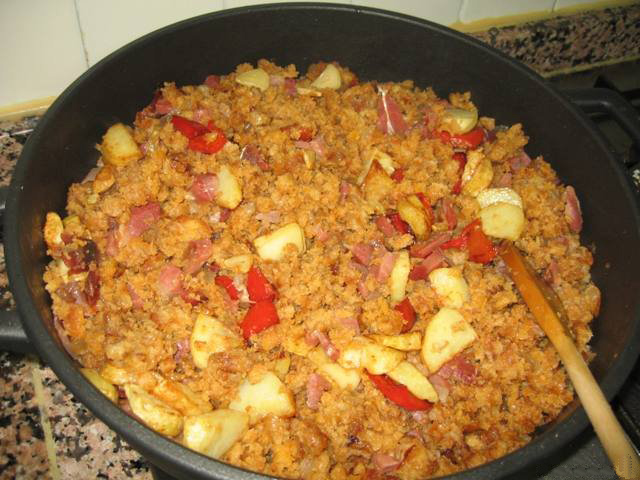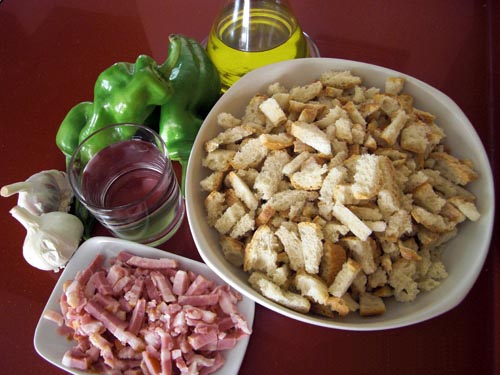
Origin: Castilla La Mancha and other regions.

Migas (which in Spanish means bread crumbs), sometimes called "migas de pastor" (shepherd's bread crumbs), is, as it's name announces, a pastoral dish. Initially it was created to make the best of the bread's leftovers. Some people believe that it's origin is related to couscous, as in Christian territories it was made with bread and they would add bacon to distinguish it from Jewish and Arab food.
However migas is one of those recipes that doesn't have an exact formula, as it greatly depends on the region, the products available and the cook, giving way to many different variants. They can be sweet or savory. In some places paprika is added to give it a reddish color, in others they're mixed in a pan with bacon, or chorizo. The sweet preparations may include grapes, melon or even chocolate.
Being such a simple recipe with such simple ingredients, it is no surprise therefore that this is a popular dish across the country. It is particularly popular in rural areas where people have had less money and so making use of old bread was a necessary way to eat. As a result, this dish is a great option for those on a small budget but who still want to try some authentic Spanish food.
Migas manchegas: common in the region of La Mancha (Castilla La Mancha). Made with very hard bread, garlic, olive oil, sausages bacon and other ingredients.
Migas from Aragon: a traditionally rural dish, made with hard bread, bacon, chorizo, garlic, onion, paprika, etc. Served with grapes.
Migas andaluzas: Mainly hard bread, garlic and olive oil, anise and bacon. Accompanied by a number of vegetables. There's also a sweet variant, adding milk or chocolate to the crumbs. Originally migas andaluzas were made at the work place (the field).
Migas murcianas or gachasmisgas: Instead of hard bread crumbs, it's made with flour, water and oil. Then they add longaniza, sausage, ñora (a dehydrated pepper original from the region). It's very typical to accompany migas murcianas with a piece of fruit such as grapes or orange. They are traditionally made when it rains.
Migas de Almería: These are made with flour or semolina and are normally eaten with lots of fish such as sardines, fried anchovies and cod, as well as fried peppers, tomato, and other meats like chorizo and black pudding. Again, this dish is normally eaten on rainy days.
Migas extremeñas: This version is made throughout Andalucia and La Mancha and tends to be served with chorizo, pepper and sardines, amongst other ingredients.
Migas a la alentejana: For the breadcrumbs used in this recipe, they use the traditional bread from Alentenjo which is very firm and rigid. To this they add pork, ribs as well as some sausage which they allow to stand fo a day before they cook the dish.
Los Turriyones: A typical version of this dish which is made in some of the areas near Aliste in the province of Zamora.
Although it's a caloric meal, great for winter, it's easy to make and uses common ingredients. If you take a language course in Spain, be sure to taste migas. If you want to make them at home, the recipe below:

Ingredients:
Preparation: